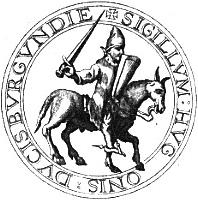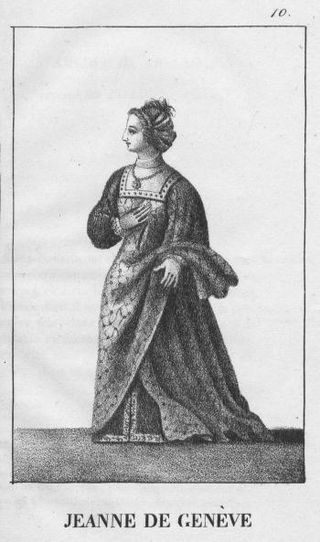Amadeus II was the count of Savoy from 1078 to 1080. His life is obscure and few documents mention him. During his rule, he was overshadowed by his mother, but he had good relations with the papacy and, for a time, the Holy Roman emperor.

Amadeus V was Count of Savoy from 1285 to 1323.
Edward (1284–1329), surnamed the Liberal, was Count of Savoy from 1323 to 1329. He was the son of Amadeus V and his first wife Sybille of Bâgé.

Amadeus VI, nicknamed the Green Count was Count of Savoy from 1343 to 1383. He was the eldest son of Aymon, Count of Savoy, and Yolande Palaeologina of Montferrat. Though he started under a regency, he showed himself to be a forceful leader, continuing Savoy's emergence as a power in Europe politically and militarily. He participated in a crusade against the Turks who were moving into Europe.

The Dauphiné is a former province in Southeastern France, whose area roughly corresponded to that of the present departments of Isère, Drôme and Hautes-Alpes. The Dauphiné was originally the Dauphiné of Viennois.

Hugh III was Duke of Burgundy between 1162 and 1192. As duke, Burgundy was invaded by King Philip II and Hugh was forced to sue for peace. Hugh then joined the Third Crusade, distinguishing himself at Arsuf and Acre. He died at Acre in 1192.
Guigues VII (1225–1269), of the House of Burgundy, was the dauphin of Vienne and count of Albon, Grenoble, Oisans, Briançon, Embrun, and Gap from 1237 to his death. He was the son of Andrew Guigues VI and Beatrice of Montferrat. When his father died, his mother helped guide the leadership of the new Dauphin.

Humbert II de la Tour-du-Pin was the Dauphin of the Viennois from 1333 to 16 July 1349. Humbert was the last dauphin before the title went to the French crown, to be bestowed on the heir apparent.

Guigues VIII de la Tour-du-Pin was the Dauphin of Vienne from 1318 to his death. He was the eldest son of the Dauphin John II and Beatrice of Hungary.

Andrew Guigues VI, known as André de Bourgogne, Dauphin of Viennois, was the Count of Albon, Briançon, Grenoble, and Oisans from 1228 until his death. He was the son of Hugh III of Burgundy and Béatrice of Albon. He took his regnal name after and inherited the titles and lands of his maternal grandfather, Guigues V.

Humbert I of Viennois was baron of la Tour-du-Pin and then also became, by his marriage, dauphin of Viennois. He was the son of Albert III, baron of la Tour-du-Pin, and of Béatrice de Coligny.

Amadeus III was the Count of Geneva from 1320 until his death. He ruled the Genevois, but not the city of Geneva proper, and it was during his time that the term "Genevois" came to be used as it is today. He was the eldest son and successor of William III and Agnes, daughter of Amadeus V of Savoy. He played a major rôle in the politics of the House of Savoy, serving consecutively as regent and president of the council, and also sitting on the feudal tribunal—one of three tribunals of the Audiences générales—of the Duchy of Aosta.

Louis I was the Baron of Vaud. At the time of his birth he was a younger son of the House of Savoy, but through a series of deaths and his own effective military service, he succeeded in creating a semi-independent principality in the pays de Vaud by 1286. He travelled widely in the highest circles of European nobility, obtained the right to mint coins from the Holy Roman Emperor, and convoked the first public assembly in the Piedmont to include members of the non-noble classes. When he died, his barony was inherited by his son.

The Château des Allymes is a thirteenth-century castle which was rebuilt in the sixteenth century and restored in the nineteenth. It is located in the hamlet of Les Allymes, in the Ambérieu-en-Bugey commune in the Ain department of France, in the Rhône-Alpes region.

Joan of Geneva was a Countess Consort of Savoy; married to Amadeus II, Count of Savoy.

Beatrice of Savoy ruled as Lady of Faucigny, having succeeded her mother, Agnes of Faucigny. She was the only legitimate child of Peter II, Count of Savoy, but did not inherit the county, which passed instead to her uncle. Beatrice was also Dauphine of Viennois and Viscountess of Béarn by her two marriages.

Guigues IV, called le Dauphin, was the count of Albon from 1133. He was the first to take the name Dauphin, meaning "dolphin", which became a title among his successors.
Marguerite de Baugé (1200-1252) was also known as Marguerite de Bâgé, as Marguerite de Baujé and as the Dame de Mirabel.
William III of Geneva was the Count of Geneva from 1308 to 1320. He was the son of count Amadeus II of Geneva, and Agnès, daughter of John, Count of Chalon.














